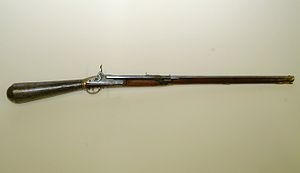Loading AI tools
Air rifle From Wikipedia, the free encyclopedia
The Girandoni air rifle is an air gun designed by Italian inventor Bartolomeo Girandoni circa 1779. The weapon was also known as the Windbüchse ("wind rifle" in German). One of the rifle's more famous associations is its use on the Lewis and Clark Expedition to explore and map the Louisiana Purchase of 1803.
This article has multiple issues. Please help improve it or discuss these issues on the talk page. (Learn how and when to remove these messages)
|
| Girandoni air rifle | |
|---|---|
 Girandoni system Austrian repeating air rifle, circa 1795, believed to have been taken on the Lewis and Clark Expedition | |
| Type | Air rifle |
| Place of origin | |
| Service history | |
| In service | 1780–1816 |
| Used by | Austrian Empire |
| Production history | |
| Designer | Bartolomeo Girandoni |
| Designed | 1779 or 1780 |
| No. built | 1,300 |
| Specifications | |
| Mass | 4.5 kg (9.9 lb) |
| Length | 120 cm (3.9 ft) |
| Cartridge | spherical balls |
| Caliber | .46", 11.7 mm 146.3 grains (9.48 g), or .51", 13 mm, 201.49 grains (13.06 g) |
| Muzzle velocity | about 600 fps (152 m/s), 117 ft lbs (159 J) |
| Feed system | 20/21 round magazine or hopper |
| Sights | Iron |

The Lewis and Clark Expedition used the rifle in the demonstrations that they performed for nearly every Native American tribe they encountered on the expedition.[1][2] Some scholars have argued that the airgun carried by Merriwether Lewis was not a Girandoni, but a Lukens, made by Isaiah Lukens of Philadelphia.[3] However, Col. Thomas Rodney wrote the following on 8 September 1803: "Visited Captain Lewess [sic] barge. He shewed us his air gun which fired 22 times at one charge."[4] All Lukens's known airguns were single-shot muzzleloaders, not repeaters, making it very likely that Lewis's gun was a Girandoni, the only repeating airgun of the time. Lewis stated in his journals that he purchased the airgun, but it is not known when or where he did so.[5] Lewis fired the airgun at least 16 times to demonstrate it to various Native American tribes. On 24 January 1806, Lewis wrote "My air gun also astonishes them very much, they cannot comprehend it's shooting so often and without powder; and think that it is great medicine."[6][7]
The rifle was four feet (1.2 m) long and weighed ten pounds (4.5 kg), about the same size and weight as infantry muskets of the time. It fired a .46 or .51 caliber ball and had a tubular, spring-fed magazine with a capacity of 20 balls.[8][9][10] Some of the weapons were also made using a gravity-fed magazine. Unlike its contemporary, muzzle-loading muskets, which required the rifleman to stand up to reload with powder and ball, the shooter could reload a ball from the magazine by pulling a transverse chamber bar out of the breech which allowed a ball to be supplied to it and which then rebounded back to its original position with the aid of a spring, all while lying down.[8]
Contemporary regulations of 1788 required that each rifleman be equipped with the rifle, three compressed air reservoirs (two spare and one attached to the rifle), cleaning stick, hand pump, lead ladle and 100 lead balls, 1 in the chamber, 19 in the magazine built into the rifle and the remaining 80 in four tin tubes. Equipment not carried attached to the rifle was held in a special leather knapsack. It was also necessary to keep the leather gaskets of the reservoir moist to maintain a good seal and prevent leakage.[11]
The air reservoir was in the club-shaped stock. With a full air reservoir, the Girardoni air rifle had the capacity to shoot 30 shots at useful pressure. These balls were effective to approximately 125 yd (114 m) on a full air reservoir. The power declined as the air reservoir was emptied.[12]
Seamless Wikipedia browsing. On steroids.
Every time you click a link to Wikipedia, Wiktionary or Wikiquote in your browser's search results, it will show the modern Wikiwand interface.
Wikiwand extension is a five stars, simple, with minimum permission required to keep your browsing private, safe and transparent.